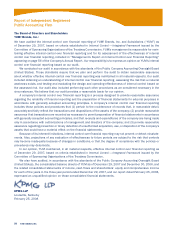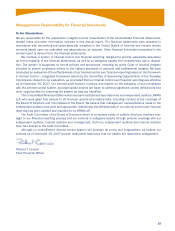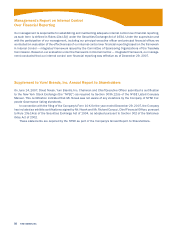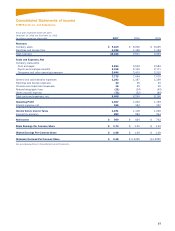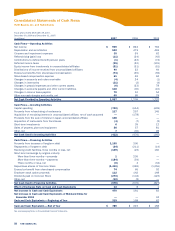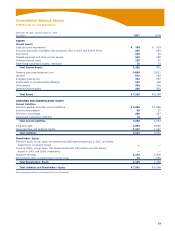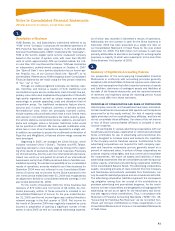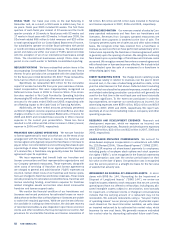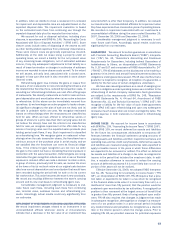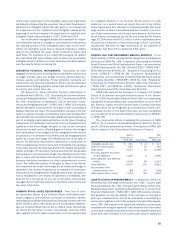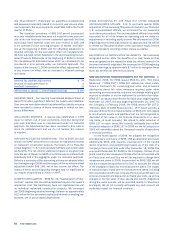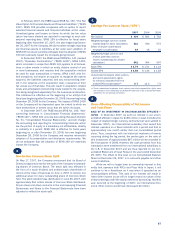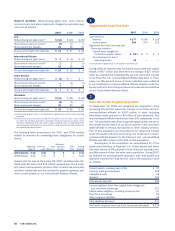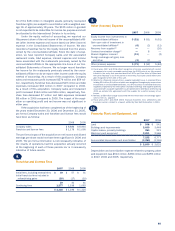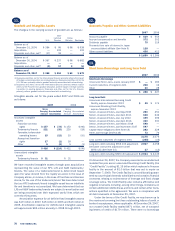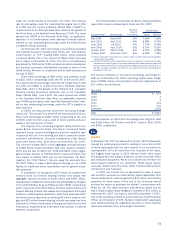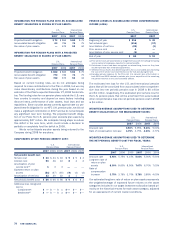Pizza Hut 2007 Annual Report Download - page 60
Download and view the complete annual report
Please find page 60 of the 2007 Pizza Hut annual report below. You can navigate through the pages in the report by either clicking on the pages listed below, or by using the keyword search tool below to find specific information within the annual report.64 YUM! BRANDS, INC.
when we considered it probable that a taxing authority may take
a sustainable position on a matter contrary to our position and
recorded any changes in judgment thereon as a component of
our annual effective rate.
The Company recognizes interest and penalties accrued
related to unrecognized tax benefits as components of its income
tax provision.
See Note 20 for a further discussion of our income taxes.
CASH AND CASH EQUIVALENTS Cash equivalents represent
funds we have temporarily invested (with original maturities not
exceeding three months) as part of managing our day-to-day
operating cash receipts and disbursements. Included in cash
equivalents are short-term, highly liquid debt securities of
$481 million and $92 million classified as held-to-maturity at
December 29, 2007 and December 30, 2006, respectively.
INVENTORIES We value our inventories at the lower of cost (com-
puted on the first-in, first-out method) or net realizable value.
PROPERTY, PLANT AND EQUIPMENT We state property, plant
and equipment at cost less accumulated depreciation and
amortization. We calculate depreciation and amortization on a
straight-line basis over the estimated useful lives of the assets
as follows: 5 to 25 years for buildings and improvements, 3
to 20 years for machinery and equipment and 3 to 7 years for
capitalized software costs. As discussed above, we suspend
depreciation and amortization on assets related to restaurants
that are held for sale.
LEASES AND LEASEHOLD IMPROVEMENTS We account for our
leases in accordance with SFAS No. 13, “Accounting for Leases”
(“SFAS 13”) and other related authoritative guidance. When deter-
mining the lease term, we often include option periods for which
failure to renew the lease imposes a penalty on the Company in
such an amount that a renewal appears, at the inception of the
lease, to be reasonably assured. The primary penalty to which
we are subject is the economic detriment associated with the
existence of leasehold improvements which might be impaired if
we choose not to continue the use of the leased property.
We record rent expense for leases that contain scheduled
rent increases on a straight-line basis over the lease term, includ-
ing any option periods considered in the determination of that
lease term. Contingent rentals are generally based on sales levels
in excess of stipulated amounts, and thus are not considered
minimum lease payments and are included in rent expense as
they accrue. We generally do not receive leasehold improvement
incentives upon opening a store that is subject to a lease.
Prior to fiscal year 2006, we capitalized rent while we were
constructing a restaurant even if such construction period was
subject to a rent holiday. Such capitalized rent was then expensed
on a straight-line basis over the remaining term of the lease upon
opening of the restaurant. Effective January 1, 2006 as required
by FASB Staff Position (“FSP”) No. 13-1, “Accounting for Rental
Costs Incurred during a Construction Period” (“FSP 13-1”), we
began expensing rent associated with leased land or buildings
for construction periods whether rent was paid or we were subject
to a rent holiday. The adoption of FSP 13-1 did not significantly
impact our results of operations in 2007 or 2006 and we do not
anticipate significant future impact.
INTERNAL DEVELOPMENT COSTS AND ABANDONED SITE COSTS
We capitalize direct costs associated with the site acquisition
and construction of a Company unit on that site, including direct
internal payroll and payroll-related costs. Only those site-specific
costs incurred subsequent to the time that the site acquisition
is considered probable are capitalized. If we subsequently make
a determination that a site for which internal development costs
have been capitalized will not be acquired or developed, any previ-
ously capitalized internal development costs are expensed and
included in G&A expenses.
GOODWILL AND INTANGIBLE ASSETS The Company accounts
for acquisitions of restaurants from franchisees and other
acquisitions of businesses that may occur from time to time in
accordance with SFAS No. 141,“Business Combinations” (“SFAS
141”). Goodwill in such acquisitions represents the excess of the
cost of a business acquired over the net of the amounts assigned
to assets acquired, including identifiable intangible assets, and
liabilities assumed. SFAS 141 specifies criteria to be used in
determining whether intangible assets acquired in a business
combination must be recognized and reported separately from
goodwill. We base amounts assigned to goodwill and other iden-
tifiable intangible assets on independent appraisals or internal
estimates. If a Company restaurant is sold within two years of
acquisition, the goodwill associated with the acquisition is writ-
ten off in its entirety. If the restaurant is refranchised beyond two
years, the amount of goodwill written off is based on the relative
fair value of the restaurant to the fair value of the reporting unit,
as described below.
The Company accounts for recorded goodwill and other intan-
gible assets in accordance with SFAS No. 142, “Goodwill and
Other Intangible Assets” (“SFAS 142”). In accordance with SFAS
142, we do not amortize goodwill and indefinite-lived intangible
assets. We evaluate the remaining useful life of an intangible
asset that is not being amortized each reporting period to deter-
mine whether events and circumstances continue to support an
indefinite useful life. If an intangible asset that is not being amor-
tized is subsequently determined to have a finite useful life, we
amortize the intangible asset prospectively over its estimated
remaining useful life. Amortizable intangible assets are amortized
on a straight-line basis.
In accordance with the requirements of SFAS 142, goodwill
has been assigned to reporting units for purposes of impairment
testing. Our reporting units are our operating segments in the
U.S. (see Note 21) and our business management units interna-
tionally (typically individual countries). We evaluate goodwill and
indefinite lived assets for impairment on an annual basis or more
often if an event occurs or circumstances change that indicate
impairments might exist. Goodwill impairment tests consist of
a comparison of each reporting unit’s fair value with its carry-
ing value. Fair value is the price a willing buyer would pay for a
reporting unit, and is generally estimated using either discounted
expected future cash flows from operations or the present value
of the estimated future franchise royalty stream plus any esti-
mated sales proceeds from refranchising. Any estimated sales
proceeds are based on relevant historical sales multiples. If the
carrying value of a reporting unit exceeds its fair value, goodwill
is written down to its implied fair value. We have selected the
beginning of our fourth quarter as the date on which to perform
our ongoing annual impairment test for goodwill. For 2007, 2006
and 2005, there was no impairment of goodwill identified during
our annual impairment testing.
For indefinite-lived intangible assets, our impairment test
consists of a comparison of the fair value of an intangible asset
with its carrying amount. Fair value is an estimate of the price a


